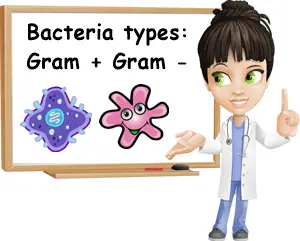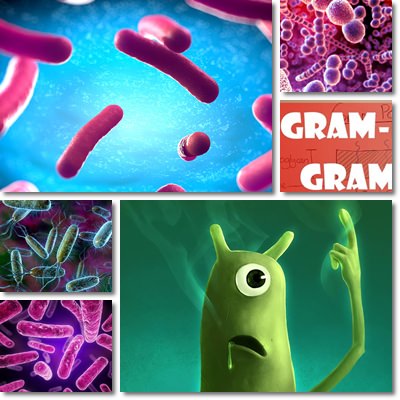Gram-negative and gram-positive bacteria are classifications of bacteria species. They refer to two large groups of the microorganism and include harmless and beneficial bacteria as well as pathogenic bacteria. Gram-negative and gram-positive pathogenic bacteria cause disease in humans and other living beings. Species commonly pathogenic to humans include Salmonella, Streptococcus, Staphylococcus, Escherichia, Mycobacterium, Clostridium and others and can affect all systems and organs, from the respiratory and digestive system to the skin, eyes or brain. The names gram-negative and gram-positive come from the test used to identify and classify bacteria, Gram’s method or the Gram stain.
Why are bacteria called gram-negative and gram-positive? The names are given based on how bacteria respond to the Gram stain test. Gram stain is a test developed by bacteriologist Hans Christian Gram and uses dyes to stain bacteria in order to identify them. The staining reveals the shape of bacteria, the physical properties of their cell walls, allowing for the classification gram-negative or gram-positive. How does the Gram stain procedure work? Different bacteria cultures are fixed on a slide using the heat fixation procedure: the slide with the bacteria culture is dried at room temperature and then passed through a flame several times.

Next, a dye called crystal violet (gentian purple or methyl violet 10B) is added to stain the bacteria, followed by a compound called iodide to help fix the dye in bacteria cells. After that, a discoloring agent is added, typically ethanol (alcohol) or acetone, to wash away the dye. The result is gram-positive bacteria remain stained purple, while gram-negative bacteria lose color. A final step includes adding a second dye, usually safranin (basic red 2) which colors gram-negative bacteria pink, revealing their morphology as well. Because it is colorless, the gram-negative bacteria picks up the second, lighter-colored dye. But the gram-positive bacteria is already purple, so the new, lighter dye won’t show.
Why does the gram positive bacteria stain purple and the gram negative stain pink? Gram-positive bacteria have one cell wall with a thick layer of peptidoglycan (basically a large sugar and amino acid molecule) which retains the purple dye. Gram-negative bacteria have two cell walls with a thin peptigoglycan layer. The discoloring agent dissolves the first outer membrane of the gram-negative bacteria called a lipopolysaccharide (basically a large lipid and sugar molecule), leaving the thin peptigoglycan exposed and unable to retain the purple dye. The only reason the second dye stains is because there is no discoloring agent added afterwards.
The Gram test also reveals bacteria shapes, allowing for a further distinction based on morphology. Thus, the main bacteria types and shapes are:
1) Coccus, cocci (spherical or ovoid in shape).
2) Bacillus, bacilli (rod-shaped).
3) Spiral-shaped bacteria (curved rods, spirals, filaments and others).
Each type may occur in the form of single cells, pairs, chains, regular or irregular clusters or various other arrangements. There are gram-positive and gram-negative bacteria of different shapes. For example: Gram-positive cocci (Streptococcus pneumoniae, Streptococcus pyogenes, Staphylococcus aureus) and bacilli (Clostridium, Listeria). Or gram-negative cocci (Escherichia, Pseudomonas, Salmonella) and spiral-shaped bacteria (Helicobacter pylori, Leptospira).
There are also bacteria which resist staining and cannot be classified as gram-negative or gram positive (example: Mycobacterium tuberculosis). Some will stain, but not to the extent needed to provide a correct and fail-proof identification. For example, some cultures of gram-positive bacteria will stain both purple and pink at the same time simply because they may have a thinner than usual layer of peptidoglycan which does not allow the cell wall to retain color well.
So what is the difference between gram positive and gram negative bacteria? Here are the main aspects to consider:

1) Gram-positive bacteria
They have a thick outer layer made from what is known as peptidoglycan and generically called a cell wall. Peptidoglycan is essentially a large molecule consisting of sugar and amino acids. It makes up the cell wall of gram-positive bacteria, or the outer layer that surrounds the bacterial cell membrane and serves a protective role. Some antibiotics are made to target this exact outer layer and stopping the production of peptidoglycan leaves the bacterium vulnerable and causes it to die. The peptidoglycan layer is also what retains the purple dye during the Gram stain test. Compared to gram-negative bacteria, this outer layer can be up to 10 times thicker.
2) Gram-negative bacteria
They have one outer membrane made from lypopolysaccharides, or lipids and chains of simple sugars. This outer membrane is followed by a thin layer of peptidoglycan located in what is known as a periplasm, or the gel-filled space between the outer and inner membrane of gram-negative bacteria. The cell membrane that surrounds the cell material comes after the peptidoglycan layer. The fact that gram-negative bacteria have two cell membranes in addition to the thin peptidoglycan layer makes them stronger pathogens, more resilient to certain antibiotics.
The lipopolysaccharide outer cell membrane contributes greatly to their resilience not only because it prevents access to the peptidoglycan layer, but also because it is toxic. More exactly, a component of this outer cell membrane called lipid A is released into the bloodstream when immune system cells attack the outer cell membrane of gram-negative bacteria. And these lipid A elements cause toxic effects and induce fever, cause diarrhea, low blood pressure and can amount to septic shock. They are also the reason why gram-negative infections are typically much more severe than gram-positive infections. Examples of infections and diseases caused by gram-negative bacteria include: bacterial meningitis, pneumonia, Chron’s disease, salmonella or infectious arthritis (see article on Arthritis: Causes, Symptoms and Treatment).
Conclusion
For the most part, the main differences are that gram-negative bacteria have two cell membranes and a very thin layer of peptidoglycan, while gram-positive bacteria have only one cell membrane and a thicker layer of peptidoglycan. These structural differences cause the first to stain pink as a result of the Gram stain test, while the second to stain purple. These characteristics also allow for gram-positive bacteria to be slightly more responsive to antibiotic treatment, whereas gram-negative bacteria can produce extremely serious infections, cause septic shock and develop resistance to antibiotics.
